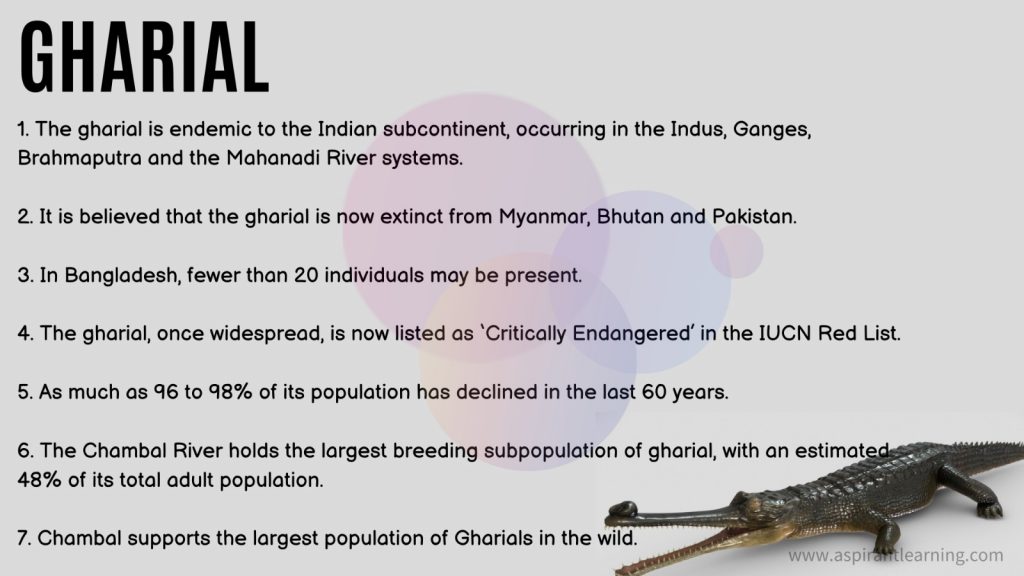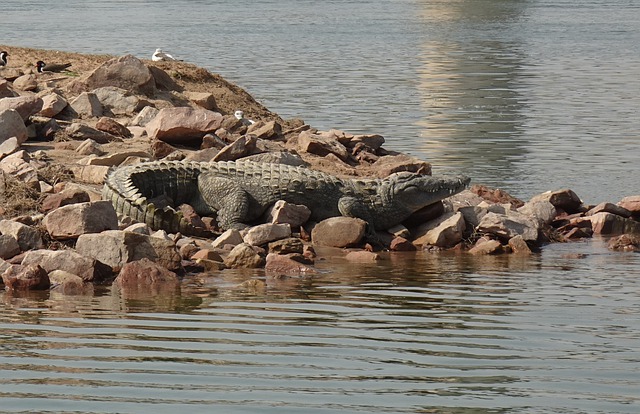News Highlights:
- Three States have commenced joint action to stop illegal sand mining in the National Chambal Sanctuary, situated at the trijunction of Rajasthan, Madhya Pradesh and Uttar Pradesh, which is known for its population of critically endangered gharials.
- To tackle this issue, a high-level meeting was held in Jaipur, where the chief secretaries of the three states discussed coordinated efforts to protect the sanctuary.
National Chambal sanctuary:
- About:
- The National Chambal Sanctuary, also known as National Chambal Gharial Wildlife Sanctuary, was founded over the Chambal River in 1979 under the crocodile conservation project to protect Indian Gharials as a riverine sanctuary.
- National Chambal Sanctuary (NCS) is a tri-state sanctuary due to its diverse area in three states.
- The Rajasthan, Madhya Pradesh and Uttar Pradesh Forest Departments manage the Sanctuary.
- This is perhaps the only wetland sanctuary in India for the conservation and management of crocodiles.
- The National Chambal Sanctuary is listed as an important bird area (IBA) and is a proposed Ramsar site.
- Chambal River:
- It is one of the tributaries of the Yamuna River and the most pollution-free river in India.
- It originates at the Singar Chouri peak on the northern slopes of the Vindhya mountains
- On its south, east and west, the basin is bounded by the Vindhyan mountain ranges and on the northwest by the Aravallis.
- The Hadauti plateau in Rajasthan occurs in the Chambal River’s upper catchment to the Mewar Plains’ southeast.
- Tributaries: Banas, Kali Sindh, Sipra, Parbati, etc.
- Major Dams on the River: Gandhi Sagar Dam, Rana Pratap Sagar Dam, Jawahar Sagar Dam.
Impact of Sand Mining from rivers:
- Alteration of Rivers:
- Excessive sand mining can alter the river bed, force the river to change course, erode banks and lead to flooding.
- It deepens rivers and estuaries and enlarges river mouths and coastal inlets.
- It may also lead to saline-water intrusion from the nearby sea.
- Damage River Biodiversity:
- Instream mining can have other costly effects beyond the immediate mine sites.
- Many hectares of fertile streamside land are lost annually, as well as valuable timber resources and wildlife habitats in the riparian areas.
- Degraded stream habitats result in loss of fisheries productivity, biodiversity, and recreational potential.
- Sand Mining in Chambal has impacted the population of Gharials (National Chambal Sanctuary has been established for their conservation), a critically endangered species.
- The mining hurts wildlife by removing basking and egg-laying habitats.
- Worsen water scarcity:
- Sand mining transforms the riverbeds into large and deep pits; as a result, the groundwater table drops, leaving the drinking water wells on the embankments of these rivers dry.
- Threat to Coastal Communities:
- Massive sand mining erodes river deltas, exposing coastal communities to severe land loss and worsening the effects of climate change-induced sea level rise.
- Damage to Public and Private Property:
- Channel incisions caused by gravel mining can undermine bridge piers and expose buried pipelines and other infrastructure.

Conclusion:
- Sand and gravel represent the highest volume of raw material used on earth after water. Their use greatly exceeds natural renewal rates.
- Moreover, the amount being mined is increasing exponentially, mainly as a result of rapid economic growth.
- To sustain economic growth in future, it becomes important that the resource is used judiciously.
Pic Courtesy: Pixabay
Content Source: The Hindu



